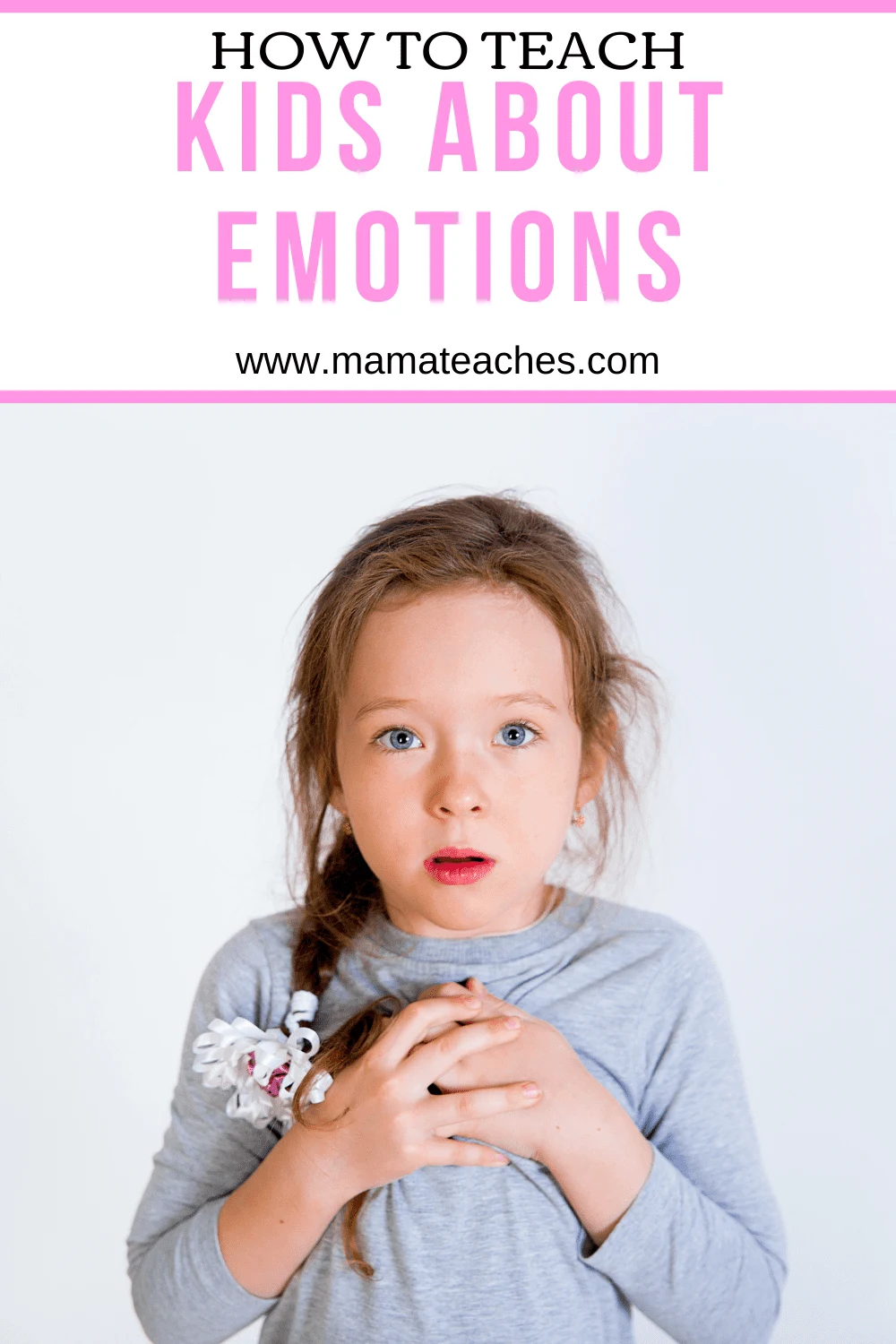Your little child feels big emotions–no one needs to teach him that!
But he does need help understanding how he feels, expressing those feelings in a safe way, and reading the emotions of others.
Keep scrolling to find out how to teach kids about emotions.
How to Teach Emotions to Toddlers
The first step in teaching emotions to toddlers is helping them to understand what they are feeling.
They are upset.
Are they angry?
Frustrated?
Sad?
Or all three?
Children need to be able to name their feelings.
This naming process begins with labeling emotions.
Just as you teach a toddler about the parts of his body (“Point to your nose!”), you can do the same with emotions.
Play the “Show Me” game
Tell your child, “Show me your happy face!” Then you make a happy face for your child to mirror.
When you clap and praise your child for her efforts, she will learn to love the game.
Ask for different emotions: sad, surprised, scared, mad, excited, tired, etc.
Label the emotion in real life
When you see your child experiencing what is clearly frustration (perhaps with a toy that won’t do what she wants) or happiness (when she is served a favorite food), label the emotion for her.
“You are feeling frustrated with that toy, aren’t you? I can see why you feel frustrated. It won’t fit in the box!”

This article contains affiliate links to things that you might like.
Label your own emotions
(Just remember this is a teaching tool and not an excuse to vent to your child.)
Keep your cool, but express how you feel when it is appropriate.
“I feel disappointed that I ran out of coffee! I need to put that on the list.”
Your child is watching your every move, and by labeling your facial expressions and mood, your child is learning to read people’s emotions (and hopefully seeing how to cope with them the right way).
Don’t punish your child for feeling
It’s a big world out there, and being a little person with limited language and control is a challenging experience.
Don’t get angry at your child for feeling strong emotions such as anger or sadness (even if you think she is overreacting).
Instead, follow this process:
- Label the emotion. (“I see you are angry that it’s time to leave the park.”)
- Be understanding. (“It’s hard to leave when we are having fun.”)
- Suggest a way to cope. (“Let’s play for two more minutes. I’ll set the timer. When we hear the beep, you can help me push the stroller to the car.”)

How to Teach Emotions to Preschoolers
Just because your preschooler is growing in language skills, you still need to focus on how to teach kids about emotions.
Building emotional control and awareness takes time!
Continue to teach self-awareness to your child
Recognizing exactly what you feel is a skill that you must hone your entire life.
You should still label emotions for your child (as you did in toddlerhood), but you can be a bit subtler. (“You seem sad. Can you tell me why?”)
Beginning readers can color an early reader I made
“My Book of Feelings,” to recognize and label emotions.
It’s available for FREE in the freebies library.
Use characters in books to develop empathy
If you notice a picture of a sad character, ask your child questions about it.
(“Why do you think Peter Rabbit is sad?”) This is not a reading comprehension question, so no answer is right or wrong.
You can always respond with, “That’s a good guess. I’d be sad if that happened to me.
Let’s see if the story tells us more about what happened to Peter Rabbit.”

Share family stories at dinner
The dinner table is a wonderful place to catch up on the day’s events.
When a family member tells a story from the day, label the emotion.
Then ask for examples from others.
(“I was happy when my coworker brought me coffee today. When have you felt happy?”)
Ask your child to imagine
Empathy develops when your child can put himself in someone else’s shoes.
This doesn’t just happen, you need to invite him into this perspective.
If you see a girl crying at the park because she skinned her knee (and someone is tending to her), you can ask your child to imagine how he would feel in the same circumstance.
(“That little girl is hurting. Imagine how you would feel if you skinned your knee. No wonder she is upset.”)
Teach coping strategies
When we are in the grip of emotions, we act out.
This is automatic–coping with our emotions takes practice.
In a quiet time (before an outburst), teach helpful responses to emotions.
(“When you feel angry, do what I do. Take three breaths as slow as you possibly can.”)
Everyone has to figure out the coping strategy that works for them (and you generally need several!).
Here are some ideas:
- Having a safe space to yell, cry, and throw a tantrum.
- Keeping a journal to write/draw (or scribble) how you feel.
- Going for a walk.
- Taking deep cleansing breaths.
- Dancing it out.
- Saying or singing a phrase to calm you. (Daniel Tiger’s Neighborhood is a gold mine for these!)
- Punching a certain pillow or punching bag.
- Yoga (yes, kids can do it too!)
These Things Take Time
Emotions don’t go away.
Children will wrestle with them their whole lives.
Knowing what they feel, expressing how they feel, and understanding how others feel are skills that every healthy adult must master.
(We are all still learning, right?)
When you know how to teach kids about emotions, you can improve your child’s emotional intelligence–and set the stage for his sense of well-being and future healthy relationships.



